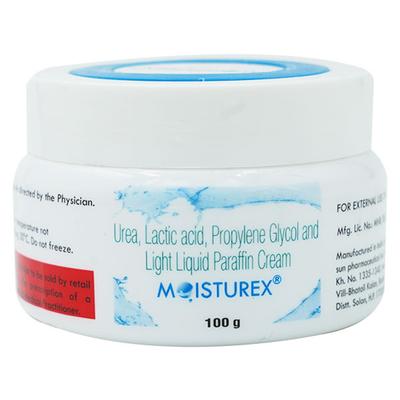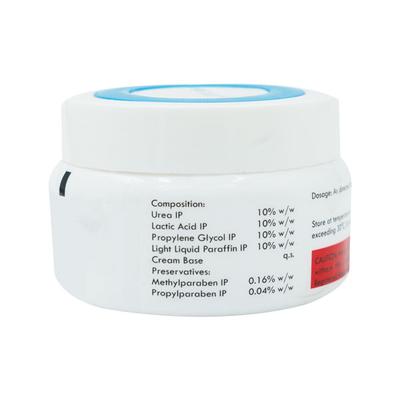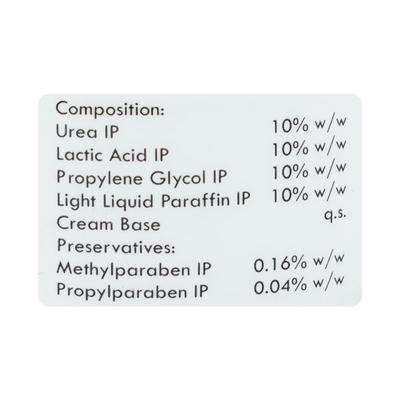

Netmeds First Membership
Quick Links
Introduction About MOISTUREX CREAM
MOISTUREX CREAM contains Lactic Acid, Liquid Paraffin, Propylene Glycol, and Urea which belong to the group of medicines called Emollients, keratolytic, and Demulcents. It is used for the management of dry fissured feet, winter itch, mild hyperkeratosis of hands and feet, post-menopausal dryness of skin, senile atrophic skin, and contact dermatitis.
Cracked heels are most commonly caused by a lack of moisture in the skin, which causes hyperkeratosis of the upper layer of skin and fissuring, which can be painful in advanced cases.
Avoid smoking or going near naked flames after applying MOISTUREX CREAM as it may increase the risk of severe burns. MOISTUREX CREAM is not recommended for use on large areas if the patient is suffering from kidney impairment.
MOISTUREX CREAM should be used with caution on damaged and inflamed skin. If you are pregnant, breastfeeding, or planning a pregnancy, consult your doctor before using MOISTUREX CREAM. MOISTUREX CREAM should be used with caution around children.
The most common side effects after using MOISTUREX CREAM are a burning sensation, skin rash, skin irritation, stinging, redness, and tingling. Consult your doctor if any of the side effects worsen.
Uses Of MOISTUREX CREAM
MOISTUREX CREAM is used in the management of skin conditions such as:
- dry fissured feet
- winter itch
- mild hyperkeratosis of hands and feet
- post-menopausal dryness of skin
- senile atrophic skin and contact dermatitis
How MOISTUREX CREAM Works
MOISTUREX CREAM contains lactic acid, which helps in the easy exfoliation of the upper dead skin layer and helps get rid of dead skin. Urea, which acts as a keratolytic agent by softening and solubilizing keratin and facilitating the easy removal of hyperkeratinized skin.
Liquid paraffin is an emollient that forms an occlusive film over the skin, thereby maintaining skin moisture and restoring skin elasticity. By managing contact with irritants and air, propylene glycol aids in the relief of inflamed and denuded skin.
How to use MOISTUREX CREAM
MOISTUREX CREAM is for external use only. Apply MOISTUREX CREAM as advised by your physician. Before applying MOISTUREX CREAM wash your feet or affected area with lukewarm water and dry the skin. Apply [GBKEYWORD] uniformly over the affected area and do not wash the area at least for 15 minutes after application.
Avoid contact with eyes, ears, nose, and mouth. Your doctor will decide the exact dose and duration of management for you depending on your age, body weight and disease condition.
Side Effects Of MOISTUREX CREAM
Common
- burning sensation
- skin rash, skin irritation
- stinging
- redness, and tingling
Rare
Stop taking MOISTUREX CREAM and consult your doctor immediately in case you experience:
- burning sensation, rash, itching
Warning & Precautions
Pregnancy
Consult your doctorIf you are pregnant or planning a pregnancy consult your doctor before using MOISTUREX CREAM.
Breastfeeding
Consult your doctorIf you are breastfeeding consult your doctor before using MOISTUREX CREAM.
Kidney
ContraindicatedMOISTUREX CREAM is not recommended for use in large areas if the patient is suffering from kidney impairment. Consult your doctor before using it.
Allergy
ContraindicatedDo not take MOISTUREX CREAM if you are allergic to Lactic Acid, Liquid Paraffin, Propylene Glycol, Urea, or any other ingredients of this medicine.
Use In Pediatrics
Use with CautionMOISTUREX CREAM should be used with caution in babies. Consult your doctor before applying it.
Others
Before taking MOISTUREX CREAM inform your doctor if you have:
- damaged and inflamed skin
Interactions
A. Drug-Drug interactions:
Before applying MOISTUREX CREAM, inform your doctor if you are taking any of the following medicine:
- dithranol (a medicine used for the management of psoriasis)
- 5-fluorouracil (a medicine used for the management of keratoses and some skin cancers)
- topical corticosteroids such as clobetasone, and hydrocortisone (medicines used for various skin problems)
Overdosage:
In case you or anybody else accidentally ingest MOISTUREX CREAM then consult your doctor immediately or visit the nearby hospital.
Synopsis
| Drug | : | Lactic Acid, Liquid Paraffin, Propylene Glycol, Urea |
| Pharmacological Category | : | Emollients, Keratolytics, Demulcents |
| Therapeutic Indication | : | Dry Fissured Feet, Mild hyperkeratosis of Hands and Feet, Post-menopausal Dryness of skin, Senile Atrophic Skin, Contact Dermatitis |
| Dosage Forms | : | Cream |
More Information
- Keep MOISTUREX CREAM out of reach from children
- Store MOISTUREX CREAM at room temperature
FAQs About MOISTUREX CREAM
Q: How does MOISTUREX CREAM heal cracked feet?
A: MOISTUREX CREAM contains lactic acid, which helps in the easy exfoliation of the upper dead skin layer and helps get rid of dead skin. Urea, which acts as a keratolytic agent by softening and solubilizing keratin and facilitating the easy removal of hyperkeratinized skin, Liquid paraffin is an emollient that forms an occlusive film over the skin, thereby maintaining skin moisture and restoring skin elasticity. Propylene glycol helps in soothing inflamed and denuded skin by managing contact with irritants and air.
Q: What are the uses of MOISTUREX CREAM?
A: MOISTUREX CREAM is used for the management of dry fissured feet, winter itch, mild hyperkeratosis of hands and feet, post-menopausal dryness of skin, senile atrophic skin, and contact dermatitis.
Q: What are the side effects of MOISTUREX CREAM?
A: The most common side effects after using MOISTUREX CREAM are burning sensations, skin rash, skin irritation, stinging, redness, and tingling. If any side effect worsens, contact your doctor.
Q: How to use MOISTUREX CREAM
A: MOISTUREX CREAM is for external use only. Apply MOISTUREX CREAM as advised by your physician. Before applying MOISTUREX CREAM, wash your feet or affected area with lukewarm water and dry the skin. Apply [GBKEYWORD] uniformly over the affected area, and do not wash the area for at least 15 minutes after application. Avoid contact with the eyes, ears, nose, and mouth. Your doctor will decide the exact dose and duration of management for you depending on your age, body weight, and disease condition.
References
1. KD Tripathi. Drugs Acting on Skin and Mucous Membranes. Essentials of Medical Pharmacology, 7th edition 2013. page 886, 889.
2. Galderma limited. Electronic Medicines Compendium. [Revised in June 2017] [Accessed on 26th September 2022] https://www.medicines.org.uk/emc/files/pil.923.pdf
3. Beiersdorf AG. Health Products Regulatory Authority. [Revised in February 2019] [Accessed on 26th September 2022] https://www.hpra.ie/img/uploaded/swedocuments/ca3c1a16-b4a2-4934-9123-c845dffee585.pdf
4. Footmark (Lactic Acid +Liquid Paraffin + Propylene Glycol +Urea). Leeford. [Accessed on 26th September 2022] https://www.leeford.in/product/1175/footmark-15-g
5. Footril (Lactic Acid +Liquid Paraffin + Propylene Glycol +Urea). Cosederma remedies. [Accessed on 26th September 2022] https://www.cosmederma.in/product/urea-10-w-w-lactic-acid-10-w-w-propylene-glycol-10-w-w-liquid-paraffin-10-w-w-cream/
6. Morise (Lactic Acid +Liquid Paraffin + Propylene Glycol +Urea). Glasier Inc. [Accessed on 26th September 2022] https://glasierwellness.com/product/morise-cream/
7. Foot Guard (Lactic Acid +Liquid Paraffin + Propylene Glycol +Urea). Torque Pharma. [Accessed on 26th September 2022] https://www.torquepharma.com/foot-guard-ointment/
8. Uremax (Lactic Acid +Liquid Paraffin + Propylene Glycol +Urea). Iscon life sciences. [Accessed on 26th September 2022] https://www.isconlifesciences.com/skin-product.php









